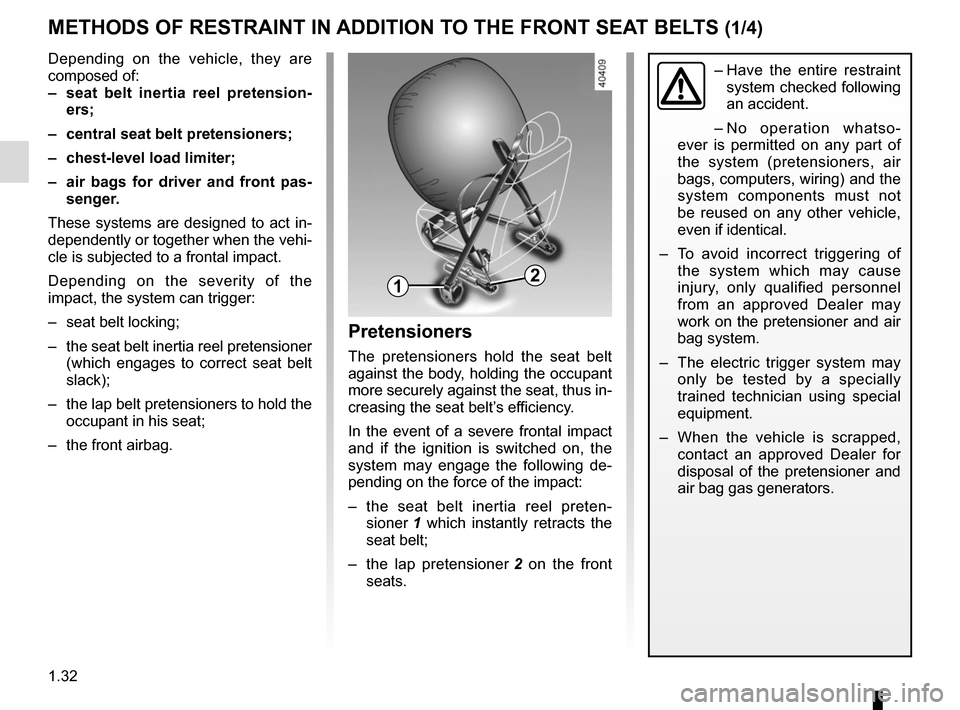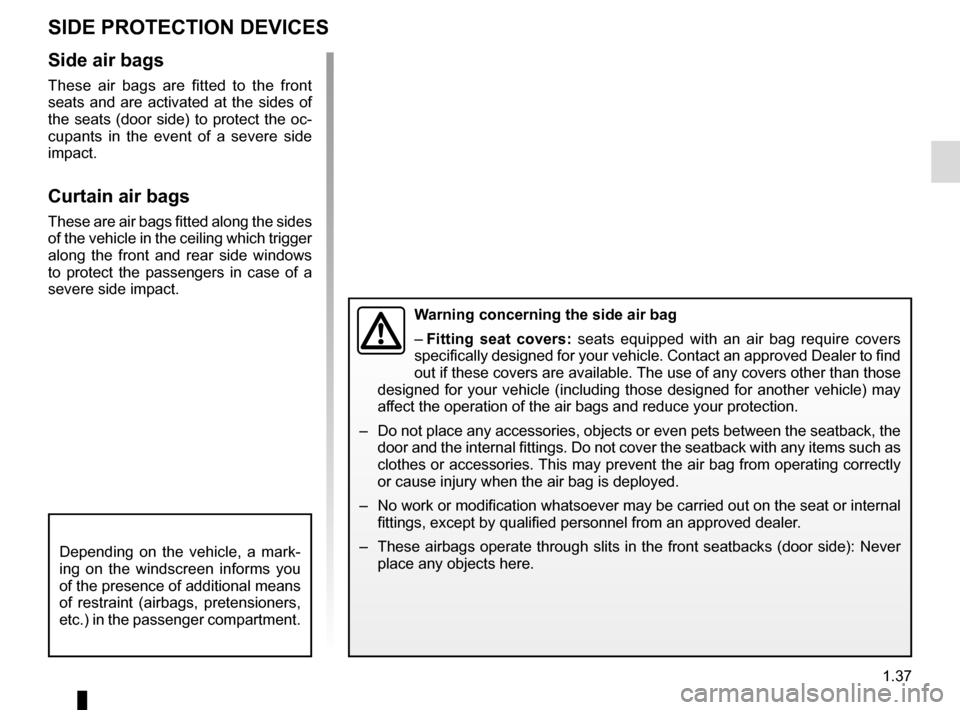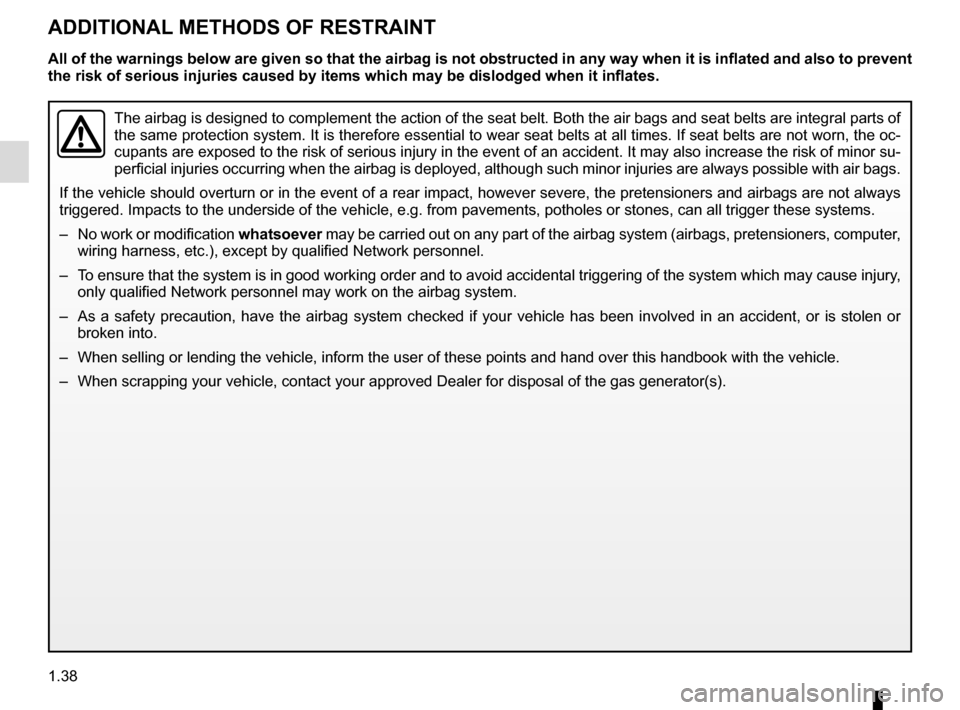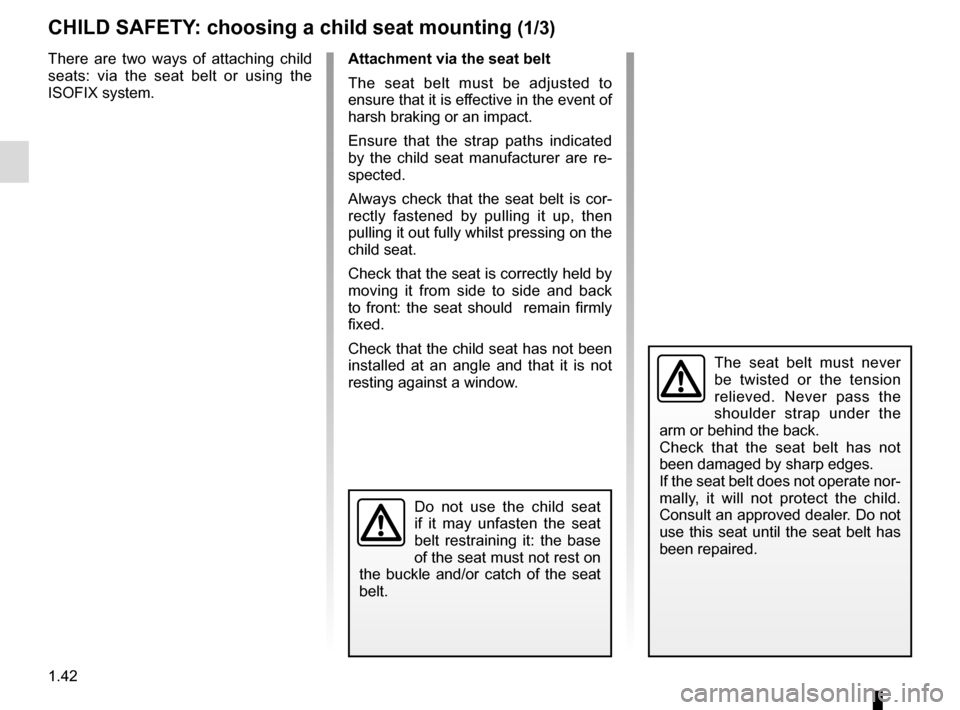2015 RENAULT ESPACE Tension
[x] Cancel search: TensionPage 38 of 316

1.32
METHODS OF RESTRAINT IN ADDITION TO THE FRONT SEAT BELTS (1/4)
Depending on the vehicle, they are
composed of:
– seat belt inertia reel pretension-ers;
– central seat belt pretensioners;
– chest-level load limiter;
– air bags for driver and front pas- senger.
These systems are designed to act in-
dependently or together when the vehi-
cle is subjected to a frontal impact.
Depending on the severity of the
impact, the system can trigger:
– seat belt locking;
– the seat belt inertia reel pretensioner (which engages to correct seat belt
slack);
– the lap belt pretensioners to hold the occupant in his seat;
– the front airbag.
Pretensioners
The pretensioners hold the seat belt
against the body, holding the occupant
more securely against the seat, thus in-
creasing the seat belt’s efficiency.
In the event of a severe frontal impact
and if the ignition is switched on, the
system may engage the following de-
pending on the force of the impact:
– the seat belt inertia reel preten- sioner 1 which instantly retracts the
seat belt;
– the lap pretensioner 2 on the front
seats.
– Have the entire restraint
system checked following
an accident.
– No operation whatso-
ever is permitted on any part of
the system (pretensioners, air
bags, computers, wiring) and the
system components must not
be reused on any other vehicle,
even if identical.
– To avoid incorrect triggering of the system which may cause
injury, only qualified personnel
from an approved Dealer may
work on the pretensioner and air
bag system.
– The electric trigger system may only be tested by a specially
trained technician using special
equipment.
– When the vehicle is scrapped, contact an approved Dealer for
disposal of the pretensioner and
air bag gas generators.
12
Page 43 of 316

1.37
SIDE PROTECTION DEVICES
Warning concerning the side air bag
– Fitting seat covers: seats equipped with an air bag require covers
specifically designed for your vehicle. Contact an approved Dealer to fi\
nd
out if these covers are available. The use of any covers other than those
designed for your vehicle (including those designed for another vehicle\
) may
affect the operation of the air bags and reduce your protection.
– Do not place any accessories, objects or even pets between the seatback,\
the door and the internal fittings. Do not cover the seatback with any items\
such as
clothes or accessories. This may prevent the air bag from operating correctly
or cause injury when the air bag is deployed.
– No work or modification whatsoever may be carried out on the seat or int\
ernal fittings, except by qualified personnel from an approved dealer.
– These airbags operate through slits in the front seatbacks (door side)\
: Never place any objects here.
Side air bags
These air bags are fitted to the front
seats and are activated at the sides of
the seats (door side) to protect the oc-
cupants in the event of a severe side
impact.
Curtain air bags
These are air bags fitted along the sides
of the vehicle in the ceiling which trigger
along the front and rear side windows
to protect the passengers in case of a
severe side impact.
Depending on the vehicle, a mark-
ing on the windscreen informs you
of the presence of additional means
of restraint (airbags, pretensioners,
etc.) in the passenger compartment.
Page 44 of 316

1.38
ADDITIONAL METHODS OF RESTRAINT
The airbag is designed to complement the action of the seat belt. Both t\
he air bags and seat belts are integral parts of
the same protection system. It is therefore essential to wear seat belts\
at all times. If seat belts are not worn, the oc-
cupants are exposed to the risk of serious injury in the event of an acc\
ident. It may also increase the risk of minor su-
perficial injuries occurring when the airbag is deployed, although such \
minor injuries are always possible with air bags.
If the vehicle should overturn or in the event of a rear impact, however\
severe, the pretensioners and airbags are not always
triggered. Impacts to the underside of the vehicle, e.g. from pavements,\
potholes or stones, can all trigger these systems.
– No work or modification whatsoever may be carried out on any part of the airbag system (airbags, pretensi\
oners, computer,
wiring harness, etc.), except by qualified Network personnel.
– To ensure that the system is in good working order and to avoid accidenta\
l triggering of the system which may cause injury, only qualified Network personnel may work on the airbag system.
– As a safety precaution, have the airbag system checked if your vehicle h\
as been involved in an accident, or is stolen or broken into.
– When selling or lending the vehicle, inform the user of these points and\
hand over this handbook with the vehicle.
– When scrapping your vehicle, contact your approved Dealer for disposal o\
f the gas generator(s).
All of the warnings below are given so that the airbag is not obstructed in any way when it is inflated and also to prevent
the risk of serious injuries caused by items which may be dislodged when\
it inflates.
Page 48 of 316

1.42
CHILD SAFETY: choosing a child seat mounting (1/3)
There are two ways of attaching child
seats: via the seat belt or using the
ISOFIX system.
The seat belt must never
be twisted or the tension
relieved. Never pass the
shoulder strap under the
arm or behind the back.
Check that the seat belt has not
been damaged by sharp edges.
If the seat belt does not operate nor-
mally, it will not protect the child.
Consult an approved dealer. Do not
use this seat until the seat belt has
been repaired.
Do not use the child seat
if it may unfasten the seat
belt restraining it: the base
of the seat must not rest on
the buckle and/or catch of the seat
belt.
Attachment via the seat belt
The seat belt must be adjusted to
ensure that it is effective in the event of
harsh braking or an impact.
Ensure that the strap paths indicated
by the child seat manufacturer are re-
spected.
Always check that the seat belt is cor-
rectly fastened by pulling it up, then
pulling it out fully whilst pressing on the
child seat.
Check that the seat is correctly held by
moving it from side to side and back
to front: the seat should remain firmly
fixed.
Check that the child seat has not been
installed at an angle and that it is not
resting against a window.
Page 155 of 316

2.43
Operating faults
If the system detects a fault, the mes-
sage “Check blind spot alert” is dis-
played on the instrument panel. Consult
an authorised dealer.
Note: When the engine is started, the
indicator light 4 (display B) flashes
three times. It is normal.
– The system’s detection
range operates according
to a standard lane width. If
you are driving in wide traf-
fic lanes, the system might not
be able to detect a vehicle in the
blind spot.
– The system might be disrupted momentarily if it is exposed to
strong electromagnetic waves
(as beneath high-tension power
lines) or to very poor weather
conditions (heavy rain, snow,
etc.). Remain aware of driving
conditions.
There is a risk of accidents.
BLIND SPOT WARNING (3/3)
Because sensors have
been installed in the bum-
pers, any work (repairs, re-
placements, touching up of
paintwork) must be carried out by a
qualified professional.
4
B
C
D
Conditions for non-function
– If the object is not moving;
– if traffic is heavy;
– the road is winding;
– if front and rear sensors both detect objects at the same time (e.g. when
passing an articulated lorry).
– ...
This function is an addi-
tional aid which indicates
other vehicles in the blind
spot area.
It can never in any case be a subs-
titute for care nor for the driver’s
responsibility while in charge of his
vehicle.
The driver should always look out
for sudden hazards during driving:
make sure while manoeuvring that
there are no moving or movable ob-
jects (such as a child, an animal, a
pushchair or a bicycle) or small or
narrow obstacles (such as a boulder
or a post) in the blind spot area.
Page 312 of 316

7.4
ALPHABETICAL INDEX (4/5)
Multi-Sense.............................................................\
.... 3.2 – 3.3
N
navigation ............................................................... 3.43 – 3.44
navigation system ................................................... 3.43 – 3.44
O
oil change ..................................................................... 4.4, 4.6
opening the doors ....................................................1.8 → 1.13
operating faults ......................................................5.31 → 5.36
overspeed warning .......................................1.70, 2.49 → 2.51
P
paintwork maintenance ..................................................... 4.14 – 4.15
parking assistance: assisted parking 2.63 → 2.66, 2.69 → 2.72
parking distance control.........................................2.63 → 2.66
power-assisted steering.................................................\
.... 1.86
powered tailgate ....................................................1.15 → 1.19
puncture................................................. 5.2 → 5.4, 5.8 → 5.11
R
radio...................................................................\
..... 3.43 – 3.44
rear drive wheels ..........................................2.26 → 2.37, 2.37
rear parcel shelf ........................................................ 3.27, 3.36
rear screen de-icing/demisting .......................................... 3.11
rear seats functions ..........................................................3.30\
→ 3.34
rear view camera .................................................... 2.67 – 2.68
rear view mirrors ....................................................1.87 → 1.89
RENAULT ANTI-INTRUDER DEVICE (RAID) ................... 1.14
RENAULT card battery ................................................................\
.......... 5.25
use ....................................................................\
...1.2 → 1.7
RENAULT card battery ...................................................... 5.25
replacement parts ................................................................ 6.7 reverse gear
selecting ..................................................2.12, 2.74 → 2.79
reversing sensor ....................................................2.63 → 2.66
roof bars ........................................................................\
.... 3.42
roof rack roof bars ....................................................................... 3.42
running in ........................................................................\
..... 2.2
S
safety distance warning .......................................... 2.44 – 2.45
safety distances ...................................................... 2.44 – 2.45
screen fold-away screen .......................................................... 1.72
navigation display .................................. 1.71, 3.43 – 3.44
navigation screen ..................................... 1.71, 3.43 – 3.44
screen wash/wipe ............................................... 1.102 – 1.103
seat belt pretensioners ..........................................1.32 → 1.35
seat belts ................................ 1.28 → 1.30, 1.32 → 1.35, 1.38
see-me-home lighting ........................................................ 1.94
service sheets..........................................................\
6.8 → 6.13
shock absorbers ................................................................ 2.73
side indicator lights changing bulbs ............................................................. 5.18
sign detection: overspeed warning ........................2.49 → 2.51
signals and lights ...................................................1.91 → 1.95
special features of diesel versions.....................................\
2.11
special features of petrol vehicles ..................................... 2.10
speed limiter ..........................................................2.46 → 2.48
starting the engine .....................................................2.3 → 2.5
steering wheel adjustment .............................................................\
...... 1.86
Stop & Start ...............................................................2.6 → 2.9
Stop & Start function..................................................2.6 → 2.9
storage compartment.............................................3.23 → 3.27
storage compartments ..................................3.23 →
3.27, 3.37
sun blinds ........................................................................\
.. 3.22